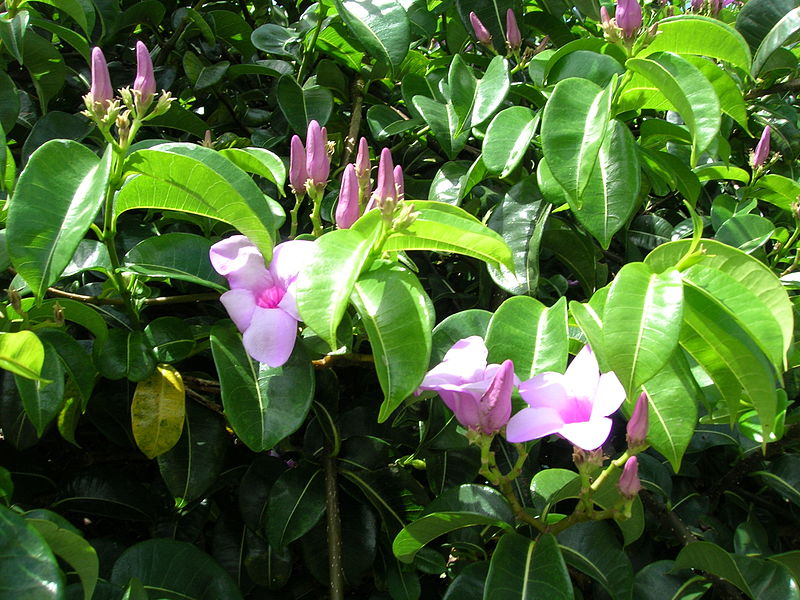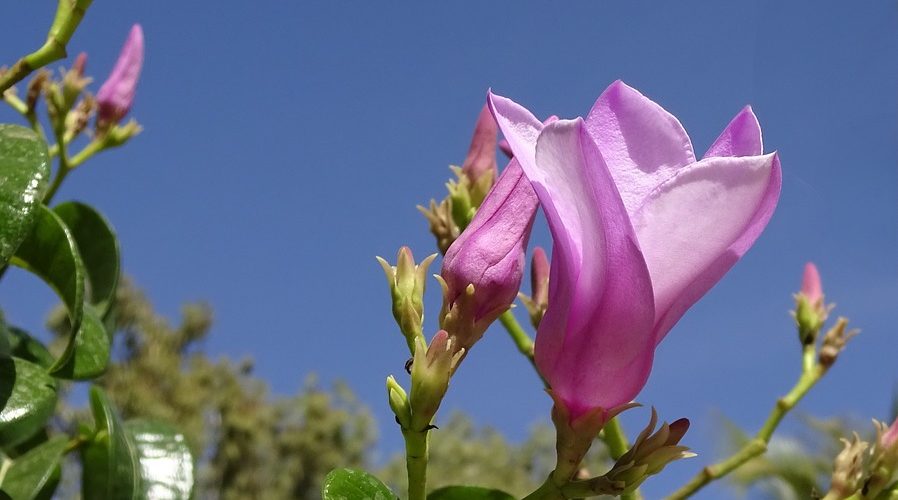

Cryptostegia grandiflora, commonly known as Rubber Vine, is a beautiful perennial ornamental plant to grow in the garden and in pots.
General characteristics of Cryptostegia grandiflora
Cryptostegia grandiflora is a perennial plant of the Apocynaceae family native to southwestern Madagascar. It is widespread in all tropical and subtropical areas and largely naturalized in East Africa, Mauritius, India, Southeast Asia, Latin America, the southern United States, Fiji and especially in Australia.
Cryptostegia is a vigorous and long-lived evergreen plant with a robust root that penetrates the ground several meters deep. In full vegetative vigor, this climbing vine has woody stems about 15 meters long with brown-greyish bark and various warty and whitish spots called lenticels.
Read also: Evergreen Magnolia Grandiflora
It has liana-like, woody stems, about 15 meters long, covered by a completely hairless leathery and shiny foliage. Stems and leaves when broken release a dense white sap that is toxic to livestock and caustic to the skin.
The leaves they are ovate-oblong and arranged opposite along the stems by means of short purple-red petioles. The leaf blade is thick, leathery, 6 to 10 cm long and 3 cm broad on average; it is dark green and glossy in the upper part, slightly lighter and opaque in the lower part; the margin is whole, sometimes wavy; the apex is sharp or blunt.
THE flowers they are showy purplish-pink in color with a darker center. They are gathered in small clusters (6-12 flowers) at the terminal ends of the branches. They have the shape of a funnel with a corolla composed of 5 large petals partially fused at the base and with slightly pointed lobes in the median part. The chalice has five narrow, ovate or lanceolate sepals. Five stamens protrude from the center of the tubule.
THE fruits, produced in divergent pairs, are three-dimensional conical follicles, 10-15 cm long and 2-4.5 cm broad. They are greenish or brownish in color, and contain numerous (200-450) seeds.

THE seeds they are dark, oblong and provided with silky hairs and once released from the dry pods they are dispersed by the wind, by the rain and also by the hair of the animals (entomophilic, hydrophilic and zoophilic dissemination). The ripe seeds can be collected and used for the next sowing, if well preserved they germinate even after one year from the harvest.
You may be interested in: Campanula grandiflora – Platycodon cultivation
Flowering
Cryptostegia blooms in summer, sometimes until the first colds of winter if temperatures are mild.
Cultivation of Cryptostegia
Exposure
Like many other plants native to tropical areas, it loves a warm climate and full sun exposure. It fears the cold and icy winds. It can be grown outdoors in a Mediterranean environment, along the warm-temperate coasts and in the Islands. Alternatively it can adapt to growing in pots, so that it can be sheltered during the cold season.
Ground
Even if it grows well in common garden soil, it prefers a specific substrate for flowering plants, rich in organic matter and with a slightly acidic pH.
The soil must be rich in organic matter. It is good to fertilize it every 15-20 days with a liquid fertilizer for flowering plants diluted in the water of the together with the irrigation water.
Watering
From the vegetative restart, from March to October, it should be watered abundantly avoiding water stagnation. In autumn-winter, watering must be reduced and practiced only to ensure the plant has sufficient humidity to resist the action of winter heating.
Fertilization
It should be fertilized with a fertilizer balanced in nitrogen (N), phosphorus (P), potassium (K) and also enriched with microelements useful for the harmonious development of both the roots and the foliage of the plant. The fertilizer must be administered every 15-20 days for the whole vegetative cycle of the plant diluted in the irrigation water.

Cryptostegia: cultivation in pots
Alternatively it can adapt to growing in pots, so that it can be sheltered during the cold season. A suitable pot should be used to contain the expansion of the root and the aerial part and generally larger than the earthen bread. The soil must be specific, loose, rich in nutrients and well drained.
To avoid contact of the root with the draining water, a layer of expanded clay or other draining material should be placed on the bottom of the pot.
Repotting
It should be repotted in early spring, gradually using a pot with a diameter of a few cm larger and new soil. To avoid damage to the roots it is advisable to repot the plant directly with its earthen bread. The final pot must not exceed 50 cm in diameter. In the latter case, the intervention is limited to the renewal of the surface soil.
Multiplication of Cryptostegia
Reproduction occurs by seed and new specimens can be obtained by cutting.
Sowing
The seeds are fertile and on average germinate giving life to new plants after 2 weeks at 20 ° C. The new specimens will produce flowers one year after sowing.
Multiplication by cuttings
New Cryptostegia plants identical to the original one are obtained by cutting.
In spring apical portions, about 8-10 cm long, are taken from healthy stems, making oblique cuts with sharp and sterilized shears to avoid the transmission of diseases.
On the cut ends of the cuttings is sprinkled with the rooting hormone powder in order to facilitate the emission and development of the roots.
The cuttings are then inserted in a box filled with a mixture of peat and sand kept just humid and placed in a shady place and a temperature between 20 and 25 ° C.
The container should be covered with a transparent plastic sheet making sure it does not touch the leaves and should be removed every day to prevent condensation from causing fungal infections and to control the humidity of the soil.
When the first shoots appear, the sheet is removed and the rooted cuttings are left to strengthen.
Planting or planting
Cryptostegia should be planted in spring, in deep holes about twice as wide as the bread of earth that surrounds the root system. The soil must be well worked, fertile and rich in organic substance, mixed with mature manure a few days before implantation.
Pruning
The plant should be pruned at the end of winter by eliminating the dry branches and shortening all the others in order to favor the emission of new stems and new shoots. If you want to grow it as a shrub, the shoots must be topped when they reach 30 cm in length and this operation must be done at the beginning of summer.
Parasites and diseases of Cryptostegia
It is a plant that fears the attack by the floury cochineal which manifests itself with white flaky deposits at the level of the leaf intersections. A small mite that suffocates the plant and especially the more tender shoots with its thin but dense cobwebs is subject to infestations by the red spider. Among the fungal diseases, on the other hand, like most plants, it fears root rot due to water stagnation.
Cures and treatments
This beautiful and long-lived climber must be supported with metal wires, poles, grids and pergolas as the longer and heavier stems tend to fall to the ground if they do not find a sturdy support on which to climb.
The scale insects can be removed manually with a cotton swab dipped in alcohol. The red spider can instead be eliminated with specific pesticides or through biological control such as the introduction into the environment of antagonistic insects such as ladybugs that are greedy for this small mite. Root rot must be prevented by ensuring the plant has a well-drained cultivation soil and avoiding stagnation of water in the saucer.

Varieties of Cryptostegia
Cryptostegia madagascariensis
Known as Madagascar rubber vine or purple rubber vine, it is a perennial climbing species with woody stems covered with opposite leaves inserted in pairs through yellowish-green petioles. Branches and young leaves have a slight down. It produces flowers with smaller petals generally of a bright pink or purplish color that are pollinated mainly by bees. The flowers only last one day. The fruits are capsules or better paired follicles about 10 cm long which turn from green to dark brown and once ripe, after about 210 days, they open, releasing an average of 95 seeds with a tuft of silky hair. Well preserved seeds have a high germination capacity.
Is Cryptostegia Poisonous?
All parts of the plant are poisonous for ingestion especially the seeds. Leaves and stems secrete a caustic sap that causes serious irritation on contact and therefore the plant must be handled with caution, protecting the hands with gardening gloves. Latex is toxic, even to large livestock that eat enough of it.
Uses
The Cryptostegia plant in our latitudes is generally cultivated as an ornamental in pot on balconies and in gardens to cover walls or to cover fences.
In the places of origin, in India and Madagascar, latex is used for the production of rubber while the fibers are used to make ropes and to make nets and lines.
English name of Cryptostegia
In England the plant is commonly called Rubber vine.
Curiosity
In Australia Cryptostegia grandiflora in particular has been declared a weed of national significance. It is considered one of the worst pests in Australia due to …



Add comment